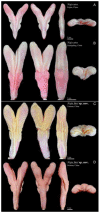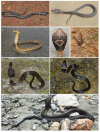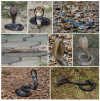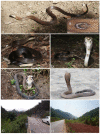Description of a New Cobra (Naja Laurenti, 1768; Squamata, Elapidae) from China with Designation of a Neotype for Naja atra
- PMID: 36552401
- PMCID: PMC9774835
- DOI: 10.3390/ani12243481
Description of a New Cobra (Naja Laurenti, 1768; Squamata, Elapidae) from China with Designation of a Neotype for Naja atra
Abstract
Taxonomic frameworks for medically important species such as cobras (genus Naja Laurenti, 1768; Squamata, Elapidae) are essential for the medical treatment of snake bites and accurate antivenin development. In this paper, we described the former N. kaouthia populations recorded from China as a new species and designated a neotype for N. atra-based morphological and mitochondrial phylogenetic analysis. The new species N. fuxisp. nov. was morphologically diagnosed from N. kaouthia by (1) regular single narrow crossband present on the middle and posterior parts of the dorsum (3-15, 7.9 ± 2.7, n = 32) and the dorsal surface of the tail (1-6, 4.2 ± 1.1, n = 32) of both adults and juveniles, buff-colored with dark fringes on both edges, vs. South Asian populations (n = 39) and Southeast Asian populations (n = 35) without cross bands, with irregular cross bands or multiple light-colored crossbands pairs, or densely woven lines; (2) small scales between the posterior chin shields, usually three (40%) or two (37%), rarely four (13%), or one (10%) (n = 30) vs. mostly one (81%) and rarely two (19%) (n = 28); (3) ventrals 179-205 (195.4 ± 6.7, n = 33) vs. South Asian populations 179-199 (188.7 ± 5.9, n = 12); Southeast Asian populations 168-186 (177.8 ± 4.9, n = 18). Phylogenetically, the new species forms an independent sister clade to the clade including N. atra, N. kaouthia, N. oxiana and N. sagittifera. Furthermore, the subspecies N. naja polyocellata should be resurrected and recognized as a full species, N. polyocellatacomb. nov., and the subspecies N. sumatrana miolepis should be resurrected.
Keywords: Asian cobras; Naja atra; Naja kaouthia; taxonomy.
Conflict of interest statement
The authors declare no conflict of interest. The funders had no role in the design of the study, in the analyses or interpretation of data, in the writing of the manuscript or in the decision to publish the results.
Figures










Similar articles
-
Cytotoxicity of Venoms and Cytotoxins from Asiatic Cobras (Naja kaouthia, Naja sumatrana, Naja atra) and Neutralization by Antivenoms from Thailand, Vietnam, and Taiwan.Toxins (Basel). 2022 May 10;14(5):334. doi: 10.3390/toxins14050334. Toxins (Basel). 2022. PMID: 35622581 Free PMC article.
-
The phylogeny, phylogeography, and diversification history of the westernmost Asian cobra (Serpentes: Elapidae: Naja oxiana) in the Trans-Caspian region.Ecol Evol. 2020 Dec 22;11(5):2024-2039. doi: 10.1002/ece3.7144. eCollection 2021 Mar. Ecol Evol. 2020. PMID: 33717439 Free PMC article.
-
Species-specific and geographical variation in venom composition of two major cobras in Indian subcontinent: Impact on polyvalent antivenom therapy.Toxicon. 2020 Dec;188:150-158. doi: 10.1016/j.toxicon.2020.10.024. Epub 2020 Oct 27. Toxicon. 2020. PMID: 33127373
-
Venomous snakebite in Thailand. I: Medically important snakes.Mil Med. 1998 May;163(5):310-7. Mil Med. 1998. PMID: 9597848 Review.
-
Taxonomic changes and toxinology: systematic revisions of the Asiatic cobras (Naja naja species complex).Toxicon. 1996 Apr;34(4):399-406. doi: 10.1016/0041-0101(95)00139-5. Toxicon. 1996. PMID: 8735239 Review.
Cited by
-
Evolution, Diversity, and Conservation of Herpetofauna.Animals (Basel). 2024 Jul 7;14(13):2004. doi: 10.3390/ani14132004. Animals (Basel). 2024. PMID: 38998116 Free PMC article.
-
Case Report: Snake Venom Ophthalmia Caused by Cobra Exposure: A Report of 26 Cases.Am J Trop Med Hyg. 2023 Nov 6;109(6):1393-1396. doi: 10.4269/ajtmh.23-0374. Print 2023 Dec 6. Am J Trop Med Hyg. 2023. PMID: 37931316 Free PMC article.
-
A new mountain pitviper of the genus Ovophis Burger in Hoge & Romano-Hoge, 1981 (Serpentes, Viperidae) from Yunnan, China.Zookeys. 2024 May 30;1203:173-187. doi: 10.3897/zookeys.1203.119218. eCollection 2024. Zookeys. 2024. PMID: 38855786 Free PMC article.
-
A Retrospective Cohort Study of Cobra Envenomation: Clinical Characteristics, Treatments, and Outcomes.Toxins (Basel). 2023 Jul 20;15(7):468. doi: 10.3390/toxins15070468. Toxins (Basel). 2023. PMID: 37505737 Free PMC article.
-
Redescription and new record of Paracapillaria (Ophidiocapillaria) najae (Nematoda: Trichuroidea) in the monocled cobra Naja kaouthia from central Thailand: morphological and molecular insights.Parasitology. 2023 Sep;150(10):901-910. doi: 10.1017/S0031182023000707. Epub 2023 Jul 31. Parasitology. 2023. PMID: 37519244 Free PMC article.
References
-
- Gong X.C., Yang W.F. Epidemiology of venomous snakebites in China. J. Emerg. Tradit. Chin. Med. 2012;21:778–780.
-
- Wei J.-F., Lü Q.-M., Jin Y., Li D.-S., Xiong Y.-L., Wang W.-Y. Alpha-neurotoxins of Naja atra and Naja kaouthia snakes in different regions. Acta Biochim. Biophys. Sin. 2003;35:683–688. - PubMed
-
- Sintiprungrat K., Watcharatanyatip K., Senevirathne W.D.S.T., Chaisuriya P., Chokchaichamnankit D., Srisomsap C., Ratanabanangkoon K. A comparative study of venomics of Naja naja from India and Sri Lanka, clinical manifestations and antivenomics of an Indian polyspecific antivenom. J. Proteom. 2015;132:131–143. doi: 10.1016/j.jprot.2015.10.007. - DOI - PubMed
-
- Ratnarathorn N., Harnyuttanakorn P., Chanhome L., Evans S.E., Day J.J. Geographical differentiation and cryptic diversity in the monocled cobra, Naja kaouthia (Elapidae), from Thailand. Zool. Scr. 2019;48:711–726. doi: 10.1111/zsc.12378. - DOI
Grants and funding
- 2019QZKK05010503/The Second Tibetan Plateau Scientific Expedition and Research Program
- XDA23080101/the Strategic Priority Research Program of the Chinese Academy of Sciences
- 32200379/National Natural Science Foundation of China
- 32160131/National Natural Science Foundation of China
- 31760623/National Natural Science Foundation of China
LinkOut - more resources
Full Text Sources

